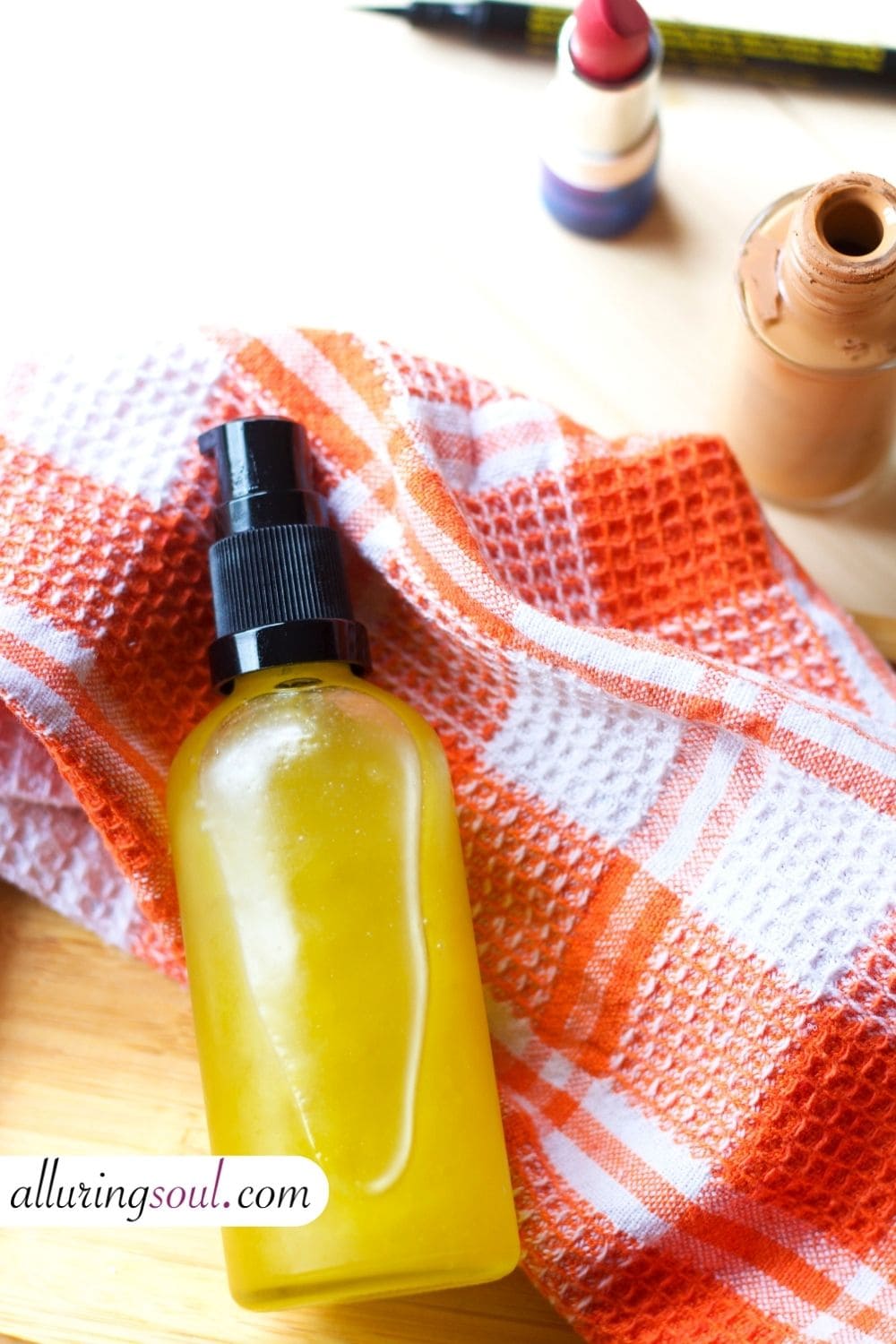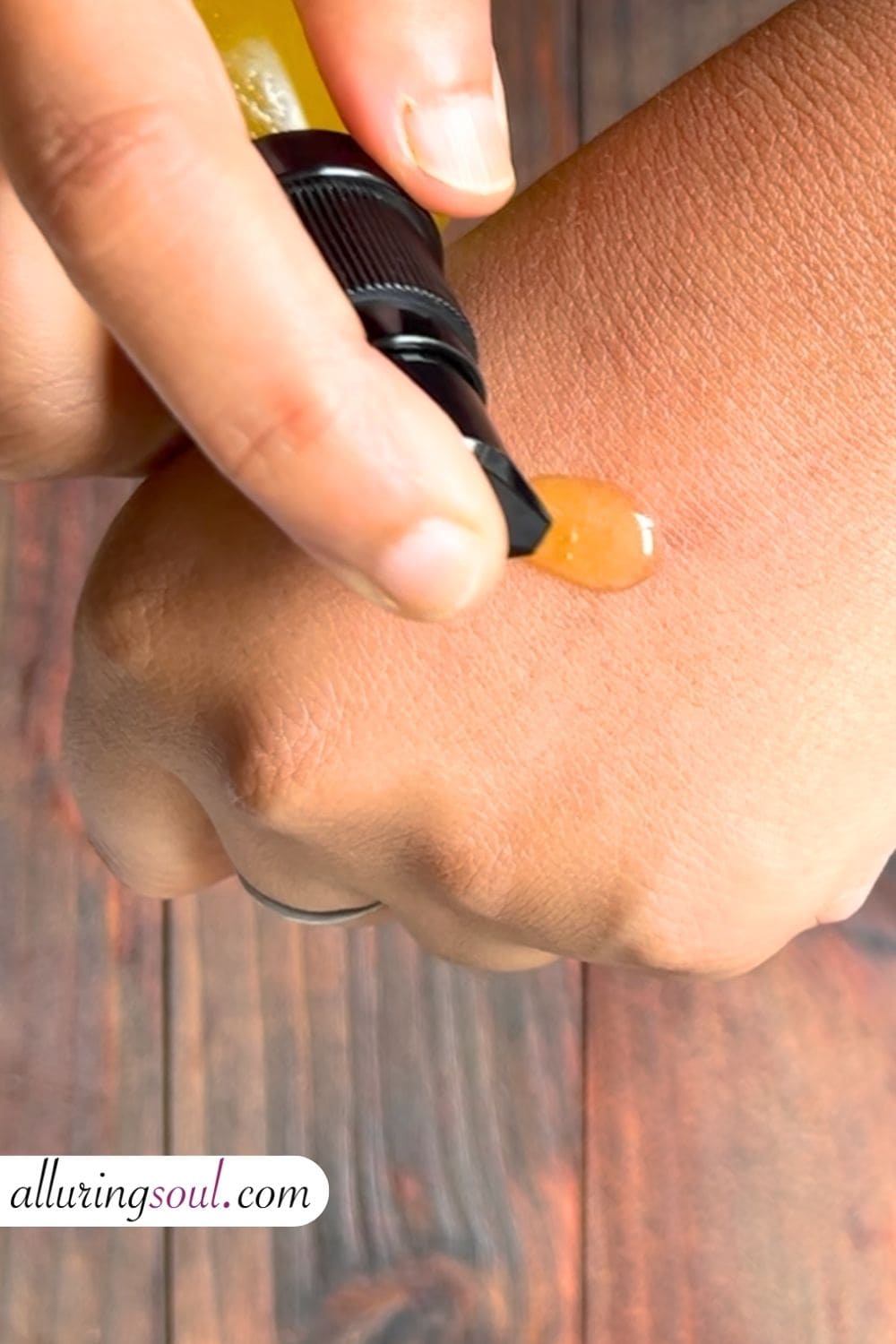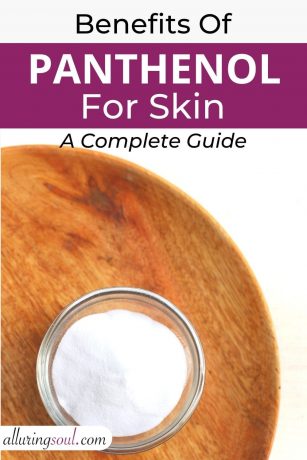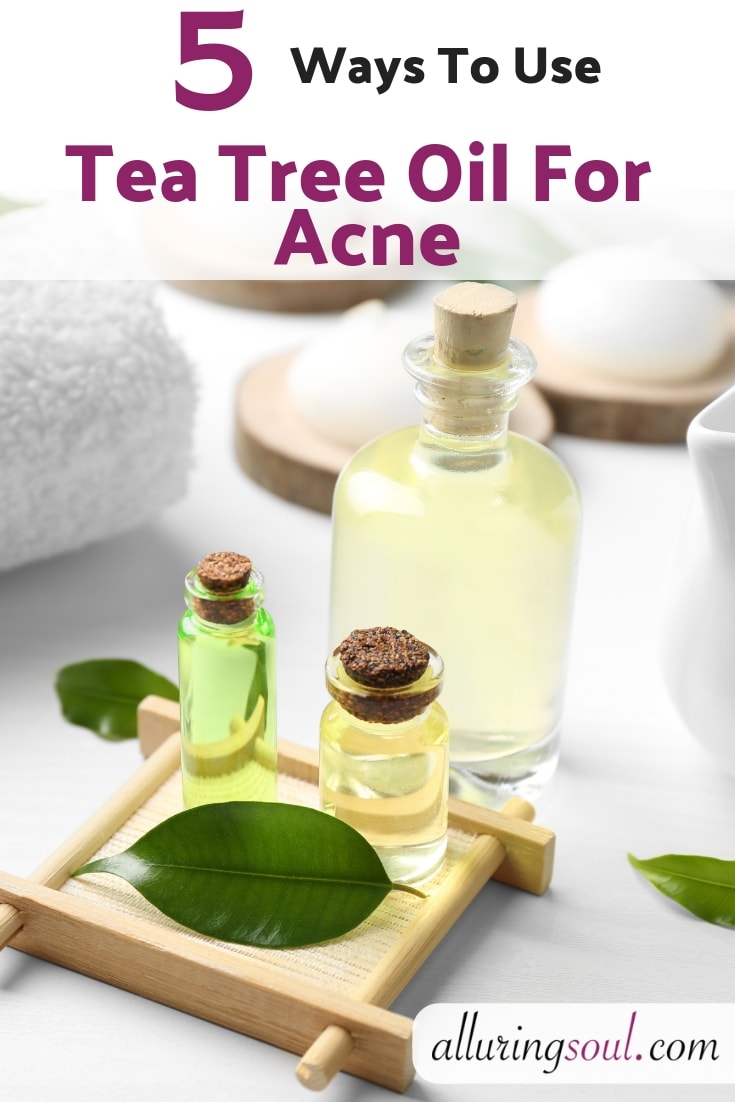Your face is exposed to a multitude of pollutants every day. All the dust particles and microbes settle in the pores of your skin and give rise to skin concerns such as clogging of pores and acne.
Here is the one-stop miracle solution to all your skincare woes. DIY Emulsifying Olive Oil Cleansing Oil. This gentle emulsifying olive oil face cleansing oil will not only remove all the pollutants and makeup from your face in a few swipes, but all leave your skin glowing and moisturized.
Dive into this article to discover more about emulsifying olive oil face cleansing oil and how to use it.
What Is Face Cleansing Oil?
Face Cleansing Oil is a type of facial cleanser that uses oils—either natural plant-based oils or synthetic ones—to gently dissolve and remove makeup, sunscreen, dirt, excess sebum, and impurities from the skin without stripping it of its natural moisture barrier.
How It Works:
- Based on the principle “like dissolves like”, cleansing oils bind to the oils on your skin (sebum, makeup, sunscreen) and help lift them away when rinsed or wiped.
- Most cleansing oils contain emulsifiers, allowing them to turn milky and rinse off easily with water, leaving no greasy residue.
Benefits:
- Effectively removes heavy makeup and waterproof sunscreen
- Maintains skin’s natural hydration
- Non-stripping and gentle—ideal for dry, sensitive, and mature skin
- Helps unclog pores and prevent blackheads (when properly rinsed)
What Is Emulsifying Cleansing Oil?
Emulsifying Cleansing Oil is a type of facial oil cleanser that contains emulsifiers, allowing the oil to mix with water and rinse off cleanly without leaving a greasy residue on the skin. These are basically oil cleansers with the added benefit of an emulsifier. In contrast to regular oil cleansers, which are difficult to wash off and have a tendency to congest the pores of the skin, emulsifying oil cleansers can be readily rinsed off.
What Makes It Different?
- While regular oils need to be wiped off, emulsifying cleansing oils turn milky upon contact with water, thanks to the emulsifier.
- This makes them ideal for removing waterproof makeup, SPF, excess sebum, and impurities from the skin without needing a second cleanser (though some still follow up with one—double cleansing).
Is Emulsifying Cleansing Oil Good For Oily Skin?
Yes, emulsifying cleansing oil is good for oily skin when formulated correctly.
- “Oil dissolves oil” principle: Cleansing oils can break down excess sebum, clogged pores, and oil-based debris without stripping your skin.
- Emulsifiers help the oil rinse off cleanly with water, leaving no greasy residue, which is essential for oily skin.
- It can gently cleanse without disrupting your skin’s natural moisture barrier, unlike harsh foaming cleansers.
Is Emulsifying Cleansing Oil Good For Dry Skin?
Yes, emulsifying cleansing oil is good for dry skin. Unlike regular foaming cleansers that can strip the face of natural oils and make it rough, emulsifying cleansers can maintain the oil balance of the face. It keeps the face moisturized, clear, and hydrated and contributes to a radiant, healthy look.
Is Emulsifying Cleansing Oil Good For Removing Blackheads?
No, emulsifying cleansing oil cannot remove blackheads.
Blackheads are formed when the excess sebum and dirt clog the pores of your skin is then oxidized by bacteria in the atmosphere, turning it black. Although emulsifying cleansing oils cannot remove blackheads, they can keep the pores of the skin free from sebum and prevent the formation of blackheads in the future.
Benefits of Ingredients Used In DIY Emulsifying Olive Oil Face Cleansing Oil
The benefits offered by the main ingredients in DIY Emulsifying Olive Oil Face Cleansing Oil are as follows:
1. Olive Oil
- Olive oil is one of the best oils used for oil cleansing. It is primarily composed of oleic acid (70%), linoleic acid (15%), palmitic acid (13%), and stearic acid (1.5%).
- It has a comedogenic rating of 1, thus ensuring that it will not clog the pores of the skin.
- It gently dissolves makeup, sunscreen, and sebum without stripping moisture.
- It nourishes and softens dry or mature skin.
- It adds slip and glide for a smooth massage during cleansing.
- Olive oil can penetrate deep into the pores of the skin and lift the dirt, oil, and bacteria clogged in them.
- Additionally, it has anti-inflammatory properties that prevent bacterial infection on the face.
2. Castor Oil
- Castor oil, which contains a high percentage of ricinoleic acid, is very useful as an oil cleanser. Although castor oil is very viscous, it has a comedogenic rating of 1. This means that it will not clog the pores of the skin.
- Castor oil is highly effective at dissolving stubborn makeup and clogged sebum.
- Castor oil has antibacterial properties that can help reduce acne-causing bacteria.
- Castor oil has the ability to exfoliate the skin. It can extract the toxins, dirt, and bacteria from the pores of the skin and unclog them. This is also useful in preventing breakouts on the skin. Additionally, castor oil can prevent flakiness of skin, improve blood circulation in the facial muscles, and prevent wrinkles on the face.
- Since castor oil is a mild astringent, it should be diluted with other oils such as olive oil to prevent drying of the skin.
3. Polysorbate 80 (Solubilizer Or Emulsifier)
Polysorbate 80 is a solubilizer and emulsifier. In emulsifying cleansing oils, Polysorbate 80 is used to add cleansing power and boost rinse-off.
Polysorbate 80 allows the oil (like olive, castor, or sunflower) to mix with water. When you rinse your face with water, polysorbate 80 emulsifies the oils, turning them into a milky lotion that can be easily rinsed off. This makes your cleanser more effective at removing dirt, makeup, sunscreen, and excess sebum.
Without an emulsifier, a cleansing oil will leave behind a greasy film on the skin. Polysorbate 80 helps avoid that by ensuring that the oil rinses away cleanly, making the product more suitable for: Oily skin, Acne-prone skin, and people who don’t want to double cleanse.
Other Properties of Polysorbate 80 –
- Appearance: Pale Yellow liquid
- Usage Rate: 1-20%
- pH: 6-8
- Solubility: Water and oil
- Charge: Nonionic
- Alternatives: There are many substitutes for polysorbate 80. You can use CreamMaker Fluid, Polyglyceryl-4 oleate, Cromollient SCE, PEG-40 Hydrogenated Castor Oil, or Olivem 300. These are all emulsifiers that can be used for making emulsifying cleansing oil. Make sure you follow the instructions and usage rates provided by your supplier for making cosmetics.
4. Cetyl Alcohol (Thickener & Co-emulsifier)
- Cetyl alcohol is a long-chain fatty alcohol that is derived from coconut oil or palm oil. In contrast to regular short-chain alcohols, which can dry out the skin, cetyl alcohol has a moisturizing effect on the skin. It leaves the skin soft, moisturized, and nourished.
- Cetyl alcohol works as a co-emulsifier and mild thickener to stabilize the oil blend.
- Cetyl alcohol acts as a multipurpose ingredient in skincare products. It works as an excellent thickener in DIY Emulsifying Olive Oil Face Cleansing Oil. Increasing the viscosity of the cleansing oil helps in the easy application of the product to the skin.
- Another use of cetyl alcohol is as a secondary emulsifier. It helps the cleansing oil and water emulsify together and boosts rinse-off without leaving any greasy residue on the skin.
Recipe For DIY Emulsifying Olive Oil Face Cleansing Oil

- 73g Extra Virgin Oilve Oil
- 10g Castor Oil
- 10g polysorbate 80 (emulsifier)
- 6g Cetyl Alcohol (thickener)
- 1g Vitamin E Oil
- Weigh the heated phase ingredients into a small heat-resistant glass measuring cup.
- Prepare a water bath or double boiler system and place the measuring cup in your prepared water bath to melt everything through.
- Once the cetyl alcohol has melted, remove the measuring cup from the water bath and let it cool at room temperature, stirring occasionally.
- When the measuring cup is barely warm to the touch, add the vitamin E and stir to combine.
- Once everything is all mixed up, transfer it to a pump bottle.
2. You can use different emulsifiers like Cromollient SCE or Olivem300 in place of polysorbate 80.
3. Always do a patch test before using any DIY products.
How To Apply Emulsifying Cleansing Oil?
- Do not wet your face first — oil works best on dry skin to dissolve makeup, sunscreen, and dirt.
- Use about 2–3 pumps (or a quarter-sized amount) into your dry palms. Rub the oil between your hands and apply it to your face. Massage in circular motions for 30–60 seconds. Focus on areas with heavy makeup, sunscreen, or blackheads (like the nose and chin).
- Now, wet your hands and continue massaging. The oil will turn milky as it emulsifies — this is normal and essential. This step breaks down oil-soluble and water-soluble impurities.
- Finally, wash your face with clean water or use a damp microfibre cloth to remove the residual emulsifying cleansing oil along with the grime from your face.
Can I Use Coconut Oil As Cleansing Oil?
No, coconut oil cannot be used as a cleansing oil. Although coconut oil has an excellent ability to dissolve dirt and oil, it has a comedogenic rating of 4. If you suffer from clogged pores, blemishes, or oily skin, or acne, do not use coconut oil for your skin. Because coconut oil has a tendency to block skin pores for some people.
But if you’re already in love with coconut oil and have used it with great success, there’s no need to panic. Everyone’s skin reacts differently to each oil type.
Can You Oil Cleanse Every Day?
Yes, you can oil cleanse every day. In fact, oil cleansing is recommended daily as a part of the PM routine. This is useful in removing all the dirt, makeup, and oil from the face gently, as well as moisturizing the face.
Do You Rinse-Off Emulsifying Cleansing Oil?
Yes, you need to rinse off the emulsifying cleansing oil.
To use an emulsifying cleansing oil, you need to introduce a small amount of water slowly as you are massaging your face. Once the emulsifying cleansing oil starts turning cloudy or milky, it begins its action of dissolving the oil and dirt from your face.
After massaging your face for 2-3 minutes, you can use a damp microfibre cloth or water to rinse off the emulsifying cleansing oil.
Should I Wash My Face Before Oil Cleansing?
No, washing your face is not necessary before oil cleansing. You can apply it on your face, having makeup or dirt.
How Long Should I Oil Cleanse For?
For a facial oil cleanser to work, you must let the oil sit on your face for a sufficient period of time. This will allow the oil particles to bind effectively to the dirt and sebum molecules on the surface of your skin.
On average, you should massage the emulsifying cleansing oil on your face for 2-3 minutes. During this time, the cleansing oil will warm up slightly, help to loosen the dirt from your face, and help it to be wiped off.
How Often Should You Oil Cleanse?
Ideally, you should oil cleanse your face once daily as a part of your nighttime skincare routine. However, the frequency of oil cleansing depends on the skin type, degree of pollution that you are exposed to, and the type of makeup that you use.
Emulsifying Face cleansing oils are useful for those who have dry skin or suffer from skin concerns like eczema. Additionally, they can also be used to remove waterproof makeup effectively.











No Comments